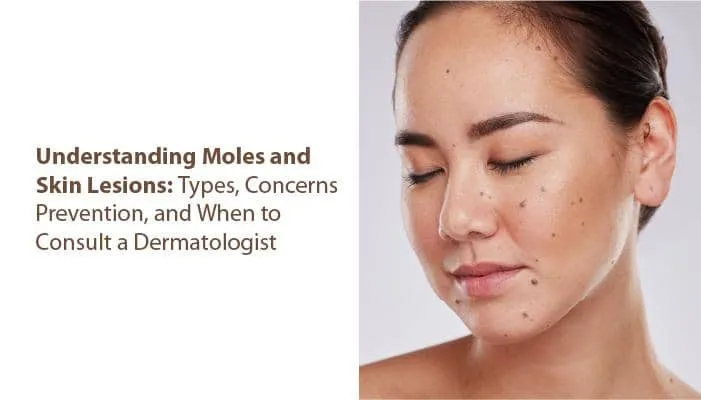Understanding Moles and Skin Lesions: Types, Concerns, Prevention, and When to Consult a Dermatologist
September 27, 2023
Introduction:
Introduce moles and skin lesions as common skin features and growths.
Mention that the blog will explore what moles and skin lesions are, different types, when to be concerned, preventive measures, available management options, and when to consult a dermatologist.
Understanding Moles and Skin Lesions:
- What Are Moles and Skin Lesions? Moles are small, pigmented skin growths and skin lesions as any abnormal change or growth on the skin.
- Types of Moles: There are different types, including common moles, dysplastic nevi, and congenital moles.
When to Be Concerned:
- Most moles and skin lesions are benign, certain characteristics can raise concerns, such as changes in size, shape, color, or the presence of itching, bleeding, or pain.
- The ABCDE rule (Asymmetry, Border, Color, Diameter, Evolving) for evaluating moles.
Types of Skin Lesions:
- Freckles: Freckles are small, flat, pigmented spots often appearing after sun exposure.
- Skin Tags: Skin tags are soft, fleshy growths that often occur in skin folds.
- Keratosis: There are different types of keratosis, such as seborrheic keratosis and actinic keratosis, which can appear as rough, scaly patches.
Prevention:
- Sun Protection: Its important to block sun and protective clothing to prevent the development of new moles and protect existing ones.
- Regular Self-Exams: Its suggested to perform regular skin self-examinations to spot changes in moles and skin lesions.
- Avoiding Irritation: Its advise against picking, scratching, or irritating moles or skin lesions.
When to Consult a Dermatologist:
- Consult a dermatologist if there are concerns about changes in moles or skin lesions, or if any concerning symptoms develop.
- Early detection and professional evaluation can help identify potential skin issues.
Conclusion:
- Key takeaways are monitoring moles and skin lesions, seeking professional evaluation when necessary, and practicing sun protection.
- Prioritize their skin health and consult dermatologists for personalized guidance.
Can moles and skin lesions be removed if they are not cancerous?
Yes, moles and skin lesions can be removed for cosmetic or comfort reasons. Consult a dermatologist for evaluation and removal options.
Are all moles and skin lesions cancerous?
No, most moles and skin lesions are benign (non-cancerous). However, it's essential to monitor them for changes and consult a dermatologist if concerned.
NOTICE BOARD
CONTACT US
CONTACT US
 Book Appointment
Book Appointment


.svg)
.svg)
.svg)
.svg)








